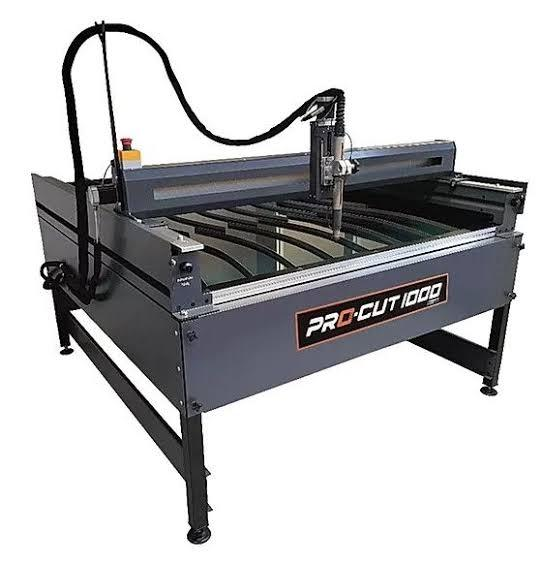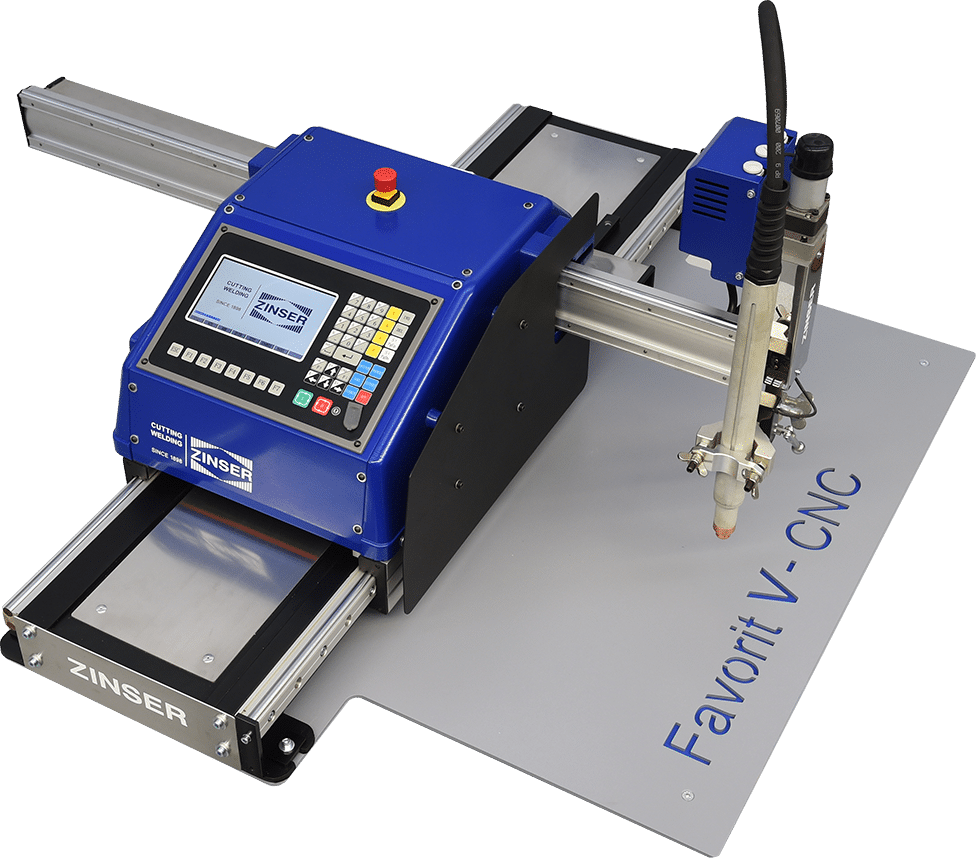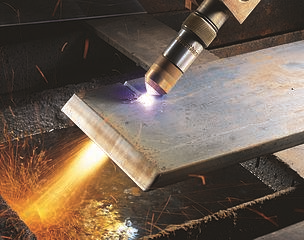Imagine being able to cut through thick metal sheets with precision and ease—a task that once seemed impossible is now a reality with CNC plasma cutting.

In this post, we’ll break down how CNC plasma cutting works, key processes, benefits, drawbacks, how to choose the best service for your workshop, and everything that’s in between. Keep reading to learn more!
What is CNC Plasma Cutting?
CNC plasma cutting is a fabrication process that is used to cut electrically conductive materials like copper, steel, aluminum, and brass accurately. The process leverages the power of a plasma jet (stream of ionized gases) that is controlled by a computer numerical control (CNC) system. The ionized gas reaches high temperatures which melt and eject the material at the cutting area, resulting in a clean cut.
It is worth mentioning that the plasma cutting cannot cut materials that are not electrically conductive like glass, stone, and paper. CNC plasma cutting is cost-effective for heavy metalworking, offering flexibility and low maintenance, especially when cutting parts with complex shapes.
But what is the working principle of a plasma cutting CNC machine? How does the machine use ionized gases to achieve smooth metal cutting?
Understanding How CNC Plasma Cutting Works

A CNC plasma cutter works by ionizing a gas to over 20,000⁰C or compressed air under pressure via a constricted opening (nozzle). The constricted nozzle forces the gases to move at high speed, generating a plasma or ionized gas, the fourth state of matter. The plasma torch is the principal piece of equipment charged with generating the plasma.
The pressure-emitted ionized gases are concentrated and directed by the CNC plasma cutter onto the metal material to be cut. The technique allows for quick and accurate cuts on both thick and thin metal sheets. The CNC plasma cutters use a variety of gases, such as nitrogen, compressed air, oxygen, or argon-hydrogen blends, depending on the material to be cut. Your choice of gas regulates the rate of the cut, the quality, and generally the efficiency of the process.
High-pressure gas and plasma mixture produce the cut through the action of mixing the plasma with pressure of the densified gas stream. Plasma incinerates through the thickness of the metal workpiece and the gas pressure blows away the incinerated material, producing a clean-cut. In simpler terms, the process of plasma cutting utilizes ionized gas to melt a metal as opposed to mechanical cutting. But not all plasma cutting systems are the same, as the cutting process is different.
Different Types of Cutting Processes

There are various plasma cutting processes available to suit your different manufacturing requirements and equipment. These different types of cutting processes have three main categories:
- Pilot Arc
In this cutting process, sparks are generated inside the torch by a combination of a low-current circuit and high voltage. This spark helps to create a pilot arc, which assists in creating a small quantity of plasma. When your CNC plasma cutter touches your metal material, the cutting arc is created, which enables you or the factory worker to start cutting.
- High-Frequency Contact
High-frequency contact is a cheap cutting process. It initiates the CNC plasma cutting process through a high-frequency spark and high voltage—the spark occurs when the plasma torch comes into contact with the metal.
The connection established completes the circuit, engages the spark, and produces the plasma used for cutting. Although the high-frequency contact process is effective, it cannot be employed in CNC plasma cutters as it may disrupt sophisticated equipment.
- Spring Loaded Plasma Torch Head
This cutting technique involves applying pressure to push the plasma torch on the metal workpiece or material to create a short circuit. Once the short circuit has been created, the flow of the current starts. To create the pilot arc, all you do is release the pressure.
Tips on Choosing the Right Gas for the Cutting Process
Plasma cutters can work with various gases, but choosing the right one is crucial. Some of the gas used for plasma cutting are listed below, along with their advantages.
| Gas Types | Uses/Advantages |
| Compressed Air | – Widely versatile and commonly used in CNC plasma cutting.
– It is a mix of nitrogen and oxygen. – Provides acceptable cut quality and speed on aluminum, mild steel, and stainless steel. – No gas extra cost, save operating cost. |
| Oxygen | – Standard for cutting mild steel.
– Reacts with steel to create a finer, more controlled molten metal spray. – Best cut quality and fastest cutting speed. – Not for aluminum or stainless steel due to oxidation. |
| Nitrogen | – Known for best cut quality, especially on aluminum and stainless steel.
– Produces smooth, precise cuts important for high-quality finishes. – Extends electrode and nozzle life, reducing maintenance costs. – More effective when combined with air or CO2. |
| Argon | – Essential for cutting nonferrous metals like aluminum and stainless steel.
– Improve accuracy, cleaner cuts, reduce slag and heat distortion. – Protects material integrity with its inert properties. – When combined with hydrogen, it increases cutting speed and efficiency. |
| Hydrogen | – Ideal for cutting thick materials like stainless steel and aluminum.
– Produces intense heat, allowing deep penetration and smooth cutting. – Best for tough, hard-to-cut materials. |
| Argon-Hydrogen Mixtures | – Combination of argon’s stability and hydrogen’s high heat conductivity.
– Provides added precision and efficiency. – Reduces material distortion and results in smoother edges. – A popular choice for heavy-duty applications |
Now that you know the gases and their benefits, here are some additional tips to help you choose the right one for your cutting needs:
- Material Type: Choose gases based on the material being cut. For example oxygen is best for mild steel, nitrogen for aluminum and stainless steel.
- Cut Quality vs. Speed: If you want a clean cut go for nitrogen or argon. For faster cutting speeds oxygen is the better choice.
- Cost Considerations: Compressed air is the cheapest gas but argon-hydrogen mix is more precise at a higher cost.
- Material Thickness: For thicker materials, gases like hydrogen or argon-hydrogen mix provide more heat and penetration for smoother cuts.
Best Materials for CNC Plasma Cutting
CNC plasma cutters use high velocity ionized gas to create a flame so they can only cut electrically conductive metals. Examples are:
| Material | Properties | Industries Used In |
| Aluminum | Its low melting point makes it easy to cut through with a plasma torch up to 160mm thickness. | Aerospace, Automotive |
| Steel | Plasma cutters can cut different types of steel, carbon steel, mild steel and stainless steel – both thin or thick steel, up to 30mm thickness. | Construction, Fabrication |
| Cast Iron | It is very conductive, has high compressive strength, and low melting temperature. Also popular for its low cost and malleability. | Construction |
| Brass | Challenging to cut due to its conductivity, requires a well-ventilated area to avoid inhaling fumes from zinc content. | Decoration, Aesthetics |
| Copper | Corrosion-resistant, highly ductile and weldable, should be cut in well-ventilated areas due to its properties | Electrical, Plumbing |
Metals that are not conductive are nearly impossible to cut by plasma. Manganese is an excellent example of a poor electricity conductor. Bismuth and tungsten have the same issue. Although Lead can be cut with a plasma cutter, the process can cause a splatter, making it dangerous, the same as working with Tin.
Pros and Cons of CNC Plasma Cutting

Using CNC plasma cutting in metal fabrication versus other methods provides you with several benefits, ranging from cost savings to higher productivity and better cut quality. However, while CNC plasma cutting most certainly presents its benefits, there are also some drawbacks. Highlighted below are some of its pros and cons:
Pros· Plasma cutting is extremely accurate and precise. · It can be used to cut many electrically conductive materials. · It is cost-effective. · There is a reduced need for extra finishing. · A CNC plasma cutter is extremely simple to operate. · It can cut up materials two times faster for dimensions up to an inch. |
Cons· It produces harmful fumes and noise. · High initial cost of machine purchase and set up. · It can provide inconsistent cuts with highly reflective surfaces. · Only effective for only materials up to about 2 inches thick. · The machine consumes a lot of electric current. · It may not match the accuracy of waterjet or laser cutting. |
How to Choose the Right Plasma Cutting Service Provider
When you are sourcing CNC plasma cutting services, it is essential to choose the right company that fits your needs. Hence, here are a few things to consider:
1. Experience and Expertise
The company providing the CNC plasma cutting service must have experience cutting specific materials with high quality. The more experienced the company, the better.
2. Cost
While you want quality, you also want to keep costs in check. When sourcing plasma cutting services, get quotes from different companies and compare prices to get the best deal.
3. Equipment and Technology
Check the equipment the plasma cutting service provider uses. The CNC machining equipment they have will affect the quality of your work. Ensure it’s the latest modern machines and software.
4. Turnaround/Delivery Time
Time is of the essence in manufacturing. When sourcing for a CNC plasma cutting service, ask questions to know when your parts will be ready. Ensure the company can meet your timeline.
5. Material Options
Not all CNC plasma cutting machines can handle every type of material. Make sure the company can cut the materials you need.
Why is LTC Proto Considered the Best Plasma Cutting Service Provider?
Finding the right CNC plasma cutting service company can make a big difference in the quality and cost of your parts.
It’s essential to choose a company that has the technology, experience, and ability to handle your materials. You can get all of these at LTC Proto, as we offer top-quality sheet metal fabrication services.
Our company is equipped with modern machinery and skilled engineers to handle a wide range of materials. At LTC Proto sheet metal fabrication factory:
- We specialize in crafting high-quality, precision-engineered metal parts.
- We deliver free quotes within 24 hours (or even within an hour for simple designs).
- We offer your company free design for manufacturing (DFM) analysis.
- Short lead time of 3-5 days with high-quality parts assured.
- Over 20 materials and 10 finishing options available.
- We conduct thorough inspections of each component to ensure it meets your specifications before shipment.
- Smooth and timely parts deliveries, as we partner with renowned delivery companies worldwide.
Want to work with us? Upload your CAD design files to our website to get an instant free quote and free DFM analysis and get your machined parts processed in the shortest time possible. You can also drop an inquiry to our contact email.
FAQs
What is the maximum thickness a plasma cutter can handle?
The maximum thickness of cut that a plasma cutter can make depends on the types of materials and the power of the machine. Hand-held plasma cutters typically cut no more than to 1.5 inches (38 mm) thick, while high-power, automated systems can handle up to 3 inches (75 mm) or more. Any thickness higher than 2 inches can be in need of other types of cutting. At LTC Proto, you’re welcome to bring your projects and we’ll help you achieve your customized details.
Can CNC plasma cut aluminum?
Aluminum is an excellent conductor of electricity, making it suitable for a CNC plasma cut. Although there are some fabricators who believe cutting aluminum on plasma cutting systems is not advisable since it possesses low melting as compared to other metals, it is still possible to produce aluminum parts with tight tolerances via plasma cutting. The outcome is enhanced by effective selection of plasma gas and cutting materials.
Is plasma cutting better than oxy-fuel cutting?
That depends. Plasma cutting is easier to learn, safer, and works best on thin material. It can also cut materials that oxy-fuel cannot, such as aluminum. However, on thicker material, oxy-fuel often has a faster cut speed and can cut thicker steel than plasma.
Conclusion
Plasma cutting is not as difficult a procedure as its name could have you believe. Provided that you carefully read the detailed explanation given in this guide on how plasma cutting operates, its advantages and disadvantages, what kind of plasma gas your materials require, and the tips to look out for when choosing a plasma cutting service provider, then you have nothing more to worry about.
If you’re new to this technique, take your time to learn what works for your manufacturing processes, follow the safety protocols, and don’t expect perfect cuts right away. However, with time, you will produce better cuts. And if you need professional services, your manufacturing needs are in good hands at LTC Proto.
